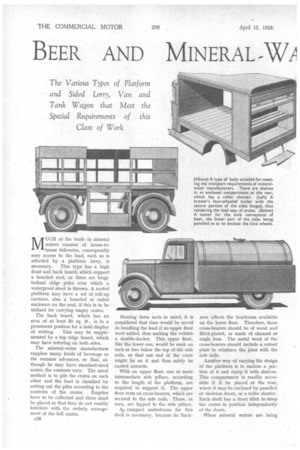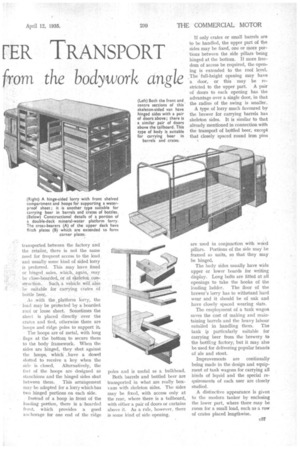BEER AND MINERAL [ER TRANSPORT from the bodywork angle Ur UCH
Page 58

Page 59

If you've noticed an error in this article please click here to report it so we can fix it.
of the trade in mineral waters consists of house-to"'house deliveries, consequently easy access to the load, such as is afforded by a platform lorry, is necessary. This type has a high front and back board; which support a boarded roof, or there are longitudinal ridge poles over which a waterproof sheet is thrown. A roofed platform may have a set of roll-up curtains, also a boarded or railed enclosure on the roof, if this is to be utilized for carrying empty crates.
The back board, which has an area of at least 30 sq. ft., is in a prominent position for a,bold display of writing. This may be supplemented by a top ridge board, which may have lettering on both sides.
The mineral-water manufacturer supplies 'many kinds of beverage as the summer advances, so that, although he may have standard-sized crates, the contents vary. The usual method is to pile the crates on each other and the load is classified by setting out the piles according to the contents of the crates. Empties have to be collected and these must be placed so that they do not readily interfere with the orderly arrangement of the full crates.
cal
Bearing these lets in mind, it is considered that time would be saved in handling the load if an upper floor werd added, thus making the vehiele a double-decker. This upper floor, like the lower one, would be sunk an inch or two below the top of the side rails, so that one end of the crate might lie on it and thus . safely be canted inwards.
With an upper floor, one or more intermediate side pillars, according to the length of the platform, are required to support it. The upper floor rests on cross-bearers, which are secured to the side rails. These, in turn, are lapped to the side pillars. compact underframe for this deck is necessary, because its thick
ness affects the headroom available on the lower floor. Therefore, these cross-bearers should be of wood and flitch-plated, or made of channel or angle iron. The metal work of the cross-bearers should include a corner plate to reinforce the joint with the side rails.
Another way of varying the design of the platform is to enclose a portion of it and equip it with shelves. This compartment is readily accessible if it be placed at the rear, where it may be enclosed by panelled or skeleton doors, or a roller shutter. Each shelf has a front fillet to keep the crates in position independently of the doors.
When mineral waters are being transported between the factory and the retailer, there is not the same need for frequent access to the load and usually some kind of sided lorry is preferred. This may have fixed or hinged sides, which, again, may be close-boarded, or of skeleton construction. Such a vehicle will also • • be suitable for carrying crates of bottle beer..
As with the platform lorry, the load may be protected by a boarded roof or loose sheet. Sometimes the sheet is placed directly over the crates and tied, otherwise there are hoops and ridge poles to support iti
• The hoops are of metal, with long flaps at the bottom to secure them to the body framework. When the sides are hinged, they shut against the hoops, which. , have a dowel slotted to receive a key when the
side is closed. Alternatively, the feet of the hoops are designed as stanchions and the hinged sides shut between them. This arra:ngement may be adopted for a lorry which has two hinged portions on each side.
Instead of a hoop in front of the loading portion, there is a boarded front, which provides a good anchorage for one end of the ridge poles and is useful as a bulkhead.
Both barrels and bottled beer are transported in what are really boxvans with skeleton sides. The sides may be fixed, with access only at the rear, where there is a tailboard, with either a pair of doors or curtains above it. As a rule, however, there is some kind of side opening. •
If only crates or small barrels are to be handled, the upper part of the sides may be fixed, one or more portions between the side pillars being hinged at the bottom. If more freedom of access be required, the opening is extended to the roof level. The 'full-height opening may have a door, or this may be restricted to the upper part. A pair of doors to each opening has the advantage over a single door, in that the radius of the swing is smaller.
A type of lorry much favoured by the brewer for carrying barrels has skeleton sides. It is similar to that already mentioned in connection with the transport of bottled beer, except that closely spaced round iron pins are used in conjunction with wood pillars. Portions of the side may be framed as units, so that they may be hinged.
The body sides usually have wide upper or lower boards for writing display. Long bolts are fitted at all openings to take the hooks of the loading ladder. The floor of the brewer's lorry has to withstand hard wear and it should be of oak and have closely spaced wearing slats.
The employment of a tank wagon saves the cost of making and maintaming barrels and the heavy labour entailed in handling them. The tank is particularly suitable for carrying beer from. the brewery to the bottling factory, but it may also be used for delivering popular brands of ale and stout.
Improvements are continually being made in the design and equipment of tank wagons for carrying all kinds of liquid and the special requirements of each user are closely studied.
A distinctive appearance is given to the modern tanker by enclosing the lower part, where there may be room for a small load, such as a row of crates placed lengthwise.












































































































